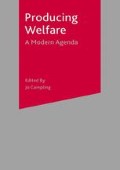Abstract
The next two chapters are concerned with the continued expansion of a mixed economy of welfare, an objective supported by all political parties. In this context, a mixed economy is understood as a diversity or plurality of public service providers operating across all sectors of social life, from the informal to non-profit, market and state sectors (Wistow et al., 1994). It also signals a plurality of relationships for the welfare consumer, often in respect of the same provider agency, alternating between a citizen exercising social rights, to that of a purchaser in the market place, or supplicant seeking assistance. If the user is confronted with multiple and diverse providers they are also themselves either required, or choose to act, as purchasers as well as recipients of services. These variable relationships in respect of the provider have, in turn, an impact upon the user’s behaviour and provide added legitimation for shifts in the welfare market place.
Preview
Unable to display preview. Download preview PDF.
Editor information
Copyright information
© 2004 Christopher Jan Miller
About this chapter
Cite this chapter
Miller, C. (2004). A Mixed Economy of Welfare: A Plurality of Providers and a Diversity of Service User Relationships. In: Campling, J. (eds) Producing Welfare. Palgrave, London. https://doi.org/10.1007/978-1-4039-3850-3_4
Download citation
DOI: https://doi.org/10.1007/978-1-4039-3850-3_4
Publisher Name: Palgrave, London
Print ISBN: 978-0-333-96093-6
Online ISBN: 978-1-4039-3850-3
eBook Packages: Palgrave Political & Intern. Studies CollectionPolitical Science and International Studies (R0)

